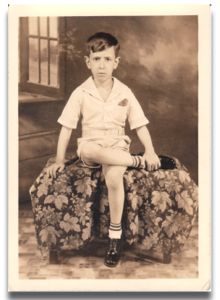It is Hollywood pop culture rooted in both history and folklore, born out of poverty row studios, aspiring movie cowboys, and a drugstore famous for its soda fountain and newsstand. Its geographical center was the intersection of Sunset Boulevard and Gower Street, but the area, and what it represents, has become better known by its somewhat less than glamorous nickname--Gower Gulch.
This location was central to a number of well known movie studios, including Columbia, Paramount, RKO and Republic Pictures. Located at the southeast corner of Gower and Sunset was the Columbia Drug Co., famous for both its soda fountain and newsstand. Both Columbia and Republic specialized in westerns during this time period, and aspiring actors, many of whom were actual working cowboys, would congregate in and around the drugstore, hoping to be selected by the studio casting agents who would frequent the area. Many of these hopefuls would come to Gower Gulch fully outfitted in their cowboy clothing and gear, and thus the moniker "drugstore cowboy" was born.
 |
| Gower Gulch as seen in Thank Your Lucky Stars |
The area was idealized in the 1943 Warner Bros. film
Thank Your Lucky Stars as a rustic colony of aspiring actors and entertainers, living in discarded movie sets. Eddie Cantor, Joan Leslie and Dennis Morgan portray three of Gower Gulch's resident hopefuls, with Morgan's character noting that he lives in the former jail set used in James Cagney's 1939 film
The Roaring Twenties. Despite conjecture otherwise (specifically a citation-less Wikipedia entry), this fanciful interpretation appears to have had no factual basis; I could not find any documentation of an actual Hollywood community consisting of individuals living in thrown away set pieces.
But Gower Gulch was in fact a community of sorts, as Time magazine described in their review of Thank Your Lucky Stars, published in October of 1943. The writer noted, "Gower Gulch is not a fiction. Although nothing like Warner Bros. moonlit version, it is one of Hollywood's minor but more durable institutions."
While the Columbia Drug Co. has received the lion's share of the historical attention relating to Gower Gulch, it was in fact another nearby establishment that was considered to be the heart and soul of this community of drugstore cowboys. The Time article identified a small Sunset Boulevard watering hole called Brewer's as the focal point for Gulch citizenry. It was run by woman named Eleanor Lathrop, who was known as the "little mother of Gower Gulch." In addition, the article provided this background:
For ten years Brewer's has been the official gathering place for Western extras and bit men, whiskery old boys who are still vicariously chasing aborigines with General Custer, discarded circus clowns and weary stuntmen who congregate to drink beer and to execute competitive embroideries on the small glories of a past day. Demigods like Gene Autry, Bob Steele and Rex Bell drop in now and then. Nearly all the Western stars have been reflected in the booze there at one time or another, but the roster of names which have been most conspicuous and most chronic during the past decade includes Handlebar Hank Bell, Bear Valley Charley, Vinegar Roan, Tex Cooper, Foxy Callaghan, Curley Rucker.
Most of these men started as genuine cowboys. All of them fill the wide-open spaces between the horses in horse operas with masculine strength and silence. Many of them get an occasional line. Perhaps the most prosperous is Handlebar Hank, who owes his modest fortune as well as his name to his mustache. More often than not, these men and others like them are picked up by studios making Westerns without working through Central Casting —a dubious practice known as "casting off the street."
 |
| "Blackjack" Jerome Moore |
Gower Gulch gained headlines and notoriety in 1939 when a disagreement between two of its citizens ended in an alleged murder. "Blackjack" Jerome Moore was accused of chasing fellow cowboy Johnny Tykes out of Brewer's and shooting him to death in a nearby parking lot. Ward was acquitted when witnesses testified that his actions were committed in self defense. According to one report, "Movie cowboys testified that Tyke was 'pizen mean' and that somebody 'had to shoot him.'"
The Gower Gulch locals elected their own mayor for the first time in 1939, It was a closely watched contest at Brewer's, where a purchase would earn you a vote. Veteran movie cowboy Jack Evans edged out his nearest competitor, a much loved pet dog named Tramp, by a slim margin of just 26 votes.
Gower Gulch is made reference to in a number of classic-era cartoons. It is the name of a town in the 1950 Looney Tunes short
All Abir-r-r-d. A year later in
Drip Along Daffy, Porky Pig sings a song entitled "The Flower of Gower Gulch." And in the 1943 Disney cartoon
Victory Vehicles, Goofy, dressed in drugstore cowboy finery, stands near the Gower Gulch Pharmacy. A grade B western entitled
The Kid from Gower Gulch was released in 1949, but bore no relation to the Hollywood locale.
Today, a small strip center located at the intersection of Sunset and Gower retains the Gower Gulch name. It is the only tangible reminder left of the area's history and of the drugstore cowboys who were once the stuff of Hollywood history and legend.
Explore 2719 Hyperion:
Disney's Hollywood: Gower Gulch and the Drugstore Cowboy

























































